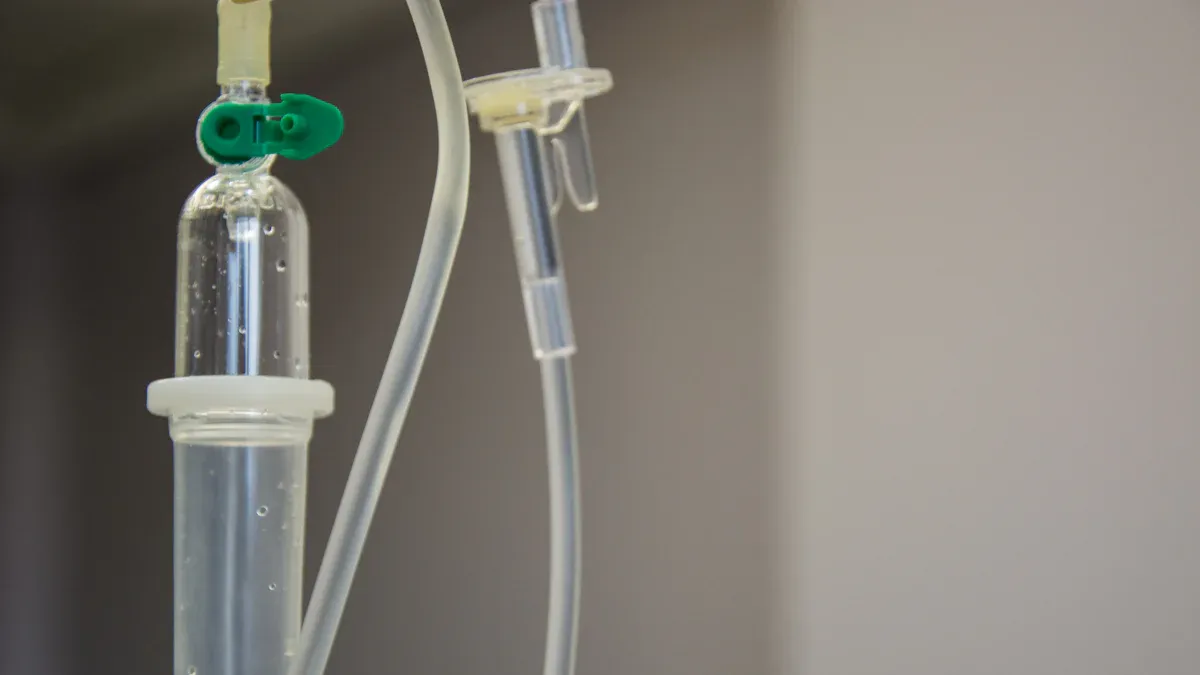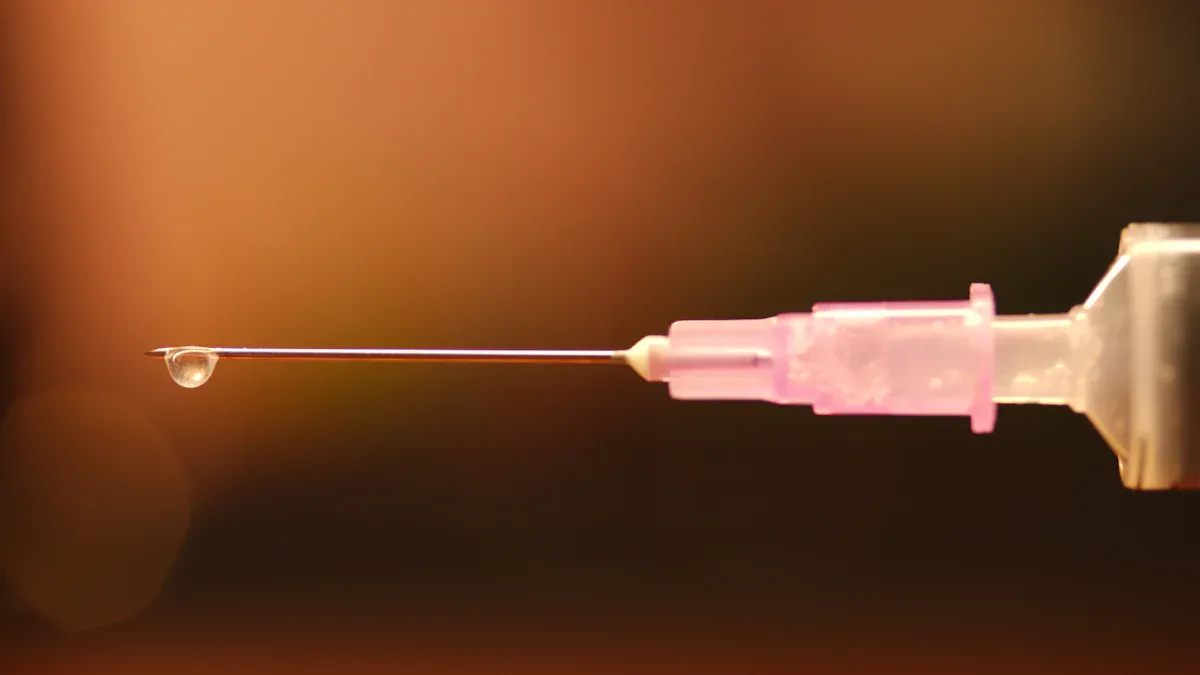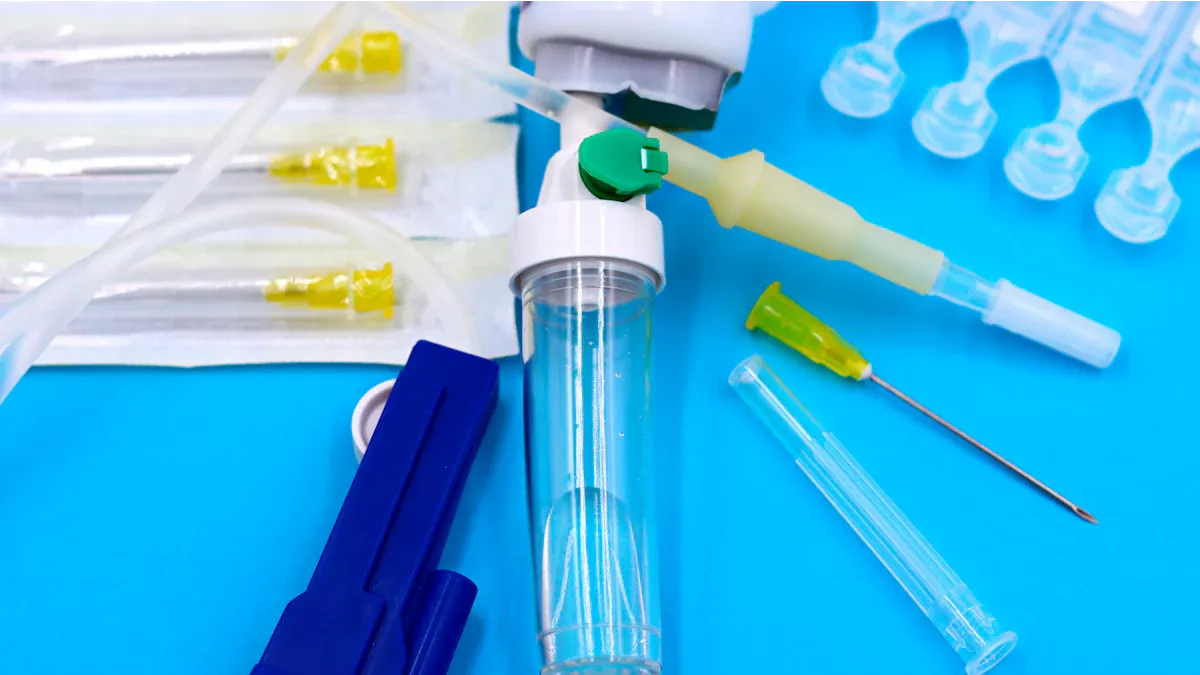How to Choose the Best ISO 10993 PET Shrink Tubing for Medical Devices

Choosing the best ISO 10993 biocompatible PET shrink tubing is important. It helps keep medical devices safe and functioning effectively. The tubing must meet strict safety regulations and perform excellently. Factors such as approval, durable materials, and proper sizing are essential. Brands like AccuPath produce high-quality ISO 10993 biocompatible PET shrink tubing that meets these requirements. Selecting the right tubing enhances the safety and reliability of medical devices.
Key Takeaways
Pick PET shrink tubing with ISO 10993 certification for safe use.
Choose the correct size and shrink ratio for a tight fit.
This helps protect devices and prevents any possible damage.
Make sure the tubing can handle heat for proper shrinking.
Check if it works well in different conditions.
Use clear PET tubing to see device parts without removing it.
Avoid mistakes like wrong sizes or uneven heating for better results.
Understanding ISO 10993 Biocompatible PET Shrink Tubing

What is ISO 10993 Certification?
ISO 10993 certification is a global standard for testing materials. It checks if materials used in medical devices are safe. For example, PET heat shrink tubing must pass these tests. The certification ensures materials do not harm or react badly with tissues.
Term | Meaning |
|---|---|
ISO 10993 | Safety of materials in medical device use |
For medical heat shrink tubing, ISO 10993 proves it meets strict rules. This certification ensures the tubing is safe and high-quality. It also confirms the tubing won’t irritate or harm patients. Using ISO 10993-certified tubing means your devices are reliable and safe.
Why ISO 10993 Matters for Medical Devices
ISO 10993 is key to making safe medical devices. It helps find risks in materials before they are used. This process ensures devices stay safe throughout their use.
Why ISO 10993 is Important:
Follows safety rules for medical devices.
Lowers the chance of bad reactions in patients.
Improves the safety of medical parts.
Evidence Type | Key Details |
|---|---|
Chemical Testing | Checks materials for safety and biocompatibility. |
Extractables Testing | Ensures no harmful substances come out of the material. |
Regulatory Compliance | Confirms materials meet medical safety laws. |
Following ISO 10993 ensures PET heat shrink tubing is safe for medical use. This is especially important in sensitive medical settings.
How ISO 10993 Ensures Safety
ISO 10993 uses tests to check material safety. These tests study how materials interact with the body. The standard has 23 sections, each focusing on a safety area.
Test Type | Purpose |
|---|---|
Cytotoxicity Testing | Checks if materials harm living cells. |
Irritation Testing | Tests if materials cause skin or tissue irritation. |
Sensitization Testing | Finds out if materials cause allergies. |
In Vitro Testing | Lab tests to check material safety early. |
In Vivo Testing | Tests on living systems to confirm safety. |
Risk Assessment | Reviews all risks to ensure safety. |
These tests make sure PET heat shrink tubing is safe and works well. Early testing finds risks before the tubing is used in devices. This helps prevent harm and keeps patients safe.
Tip: Always check if PET heat shrink tubing meets ISO 10993 standards. This ensures it is safe and high-quality for medical use.
Key Properties of Medical PET Shrink Tubing

Biocompatibility and Compliance with Standards
When picking PET shrink tubing, biocompatibility is very important. The tubing must follow ISO 10993 rules to be safe for human contact. This certification ensures the material won’t cause problems like irritation or allergies. PET tubing also meets FDA and CE rules, which set safety and performance standards. These rules protect patients and make devices more reliable.
PET tubing is made to meet strict biocompatibility needs. It avoids harmful effects on the body, making it good for sensitive uses like implants. Choosing tubing that follows these rules ensures your devices are safe and high-quality.
Durability and Mechanical Strength
Durability is another important feature of PET shrink tubing. The tubing must handle stress without losing its strength. PET tubing is tough and stays strong even in harsh conditions or with repeated use. Its tensile strength stops it from stretching or tearing. It also resists moisture and chemicals, making it work well in tough environments.
The tubing protects against damage like scratches, punctures, and impacts. This makes it great for covering delicate parts in medical devices. Its smooth surface helps stop bacteria from growing, improving safety in clean areas.
Property | Description |
|---|---|
Tensile Strength | Prevents stretching or tearing under stress. |
Resistance to Moisture | Works well in wet or tough conditions. |
Chemical Resistance | Handles cleaning agents and disinfectants safely. |
Mechanical Protection | Guards against scratches, punctures, and impacts. |
Smooth Surface | Helps stop bacteria growth in clean spaces. |
Heat Resistance and Shrink Performance
PET shrink tubing handles heat and shrinking very well. It works in temperatures from -196°C to 135°C for long periods. It can also handle short bursts of heat up to 200°C. This keeps the tubing strong even in extreme conditions. Its melting point of 235°C shows how tough it is.
The tubing shrinks tightly to fit parts securely. It has a shrink ratio of 1.1:1 and recovers over 20%. This ensures proper insulation for medical devices, preventing electrical problems. Picking PET tubing with great heat resistance and shrink ability improves device safety and performance.
Specification | Value |
|---|---|
-196°C to 135°C | |
Short-term temperature | Up to 200°C |
Melting point | 235°C |
Shrinkage target ratio | 1.1:1 |
Recovery | >20% |
Tip: Check the heat resistance and shrink specs of PET tubing. This ensures it works well for your medical devices.
Transparency and Appearance Benefits
Clear tubing is very useful for medical devices. It lets you see the parts it covers. This helps you spot problems like cracks or dirt quickly. You don’t need to remove the tubing to check for issues. For medical tools, this visibility makes them safer and more reliable.
The look of PET shrink tubing is another big plus. Its shiny, smooth surface makes devices look neat and professional. This is important for tools patients see, where appearance matters. A clear and polished finish shows the device is high-quality and well-made.
Tip: Pick PET shrink tubing with clear material for better use and looks.
Why Clear PET Tubing is Helpful:
Better Checking: See inside without taking the device apart.
Safer Devices: Spot problems early to avoid failures.
Easy Cleaning: Clear tubing makes cleaning and fixing simpler.
Feature | Benefit |
|---|---|
Clear Material | Lets you check parts inside easily. |
Smooth Finish | Gives a clean and professional look. |
UV Protection | Stops yellowing, keeping it clear longer. |
Using clear PET shrink tubing makes medical devices work well and look good. This mix of usefulness and style makes it a smart choice for many medical uses.
Note: Always check how clear the tubing is to fit your needs.
Factors to Think About When Picking PET Tubing for Medical Devices
Size and Accurate Measurements
Picking the right size for PET heat shrink tubing is very important. The tubing must fit medical device parts perfectly. If it’s too loose or tight, it can cause problems. Loose tubing might not protect well, while tight tubing can damage the device. Measure the part’s diameter and choose tubing with the correct shrink ratio for a snug fit.
Accurate measurements also help keep devices working properly. Tubing with even wall thickness and consistent size works better. Manufacturers give detailed specs to help you compare and pick the right size.
Tip: Check the shrinkage percentage before choosing tubing size. This ensures it fits well after shrinking.
Shrink Ratio and Recovery Ability
Shrink ratio shows how much tubing shrinks when heated. PET heat shrink tubing usually shrinks between 1.1:1 and 3:1. Higher ratios fit parts with different sizes, while lower ratios fit uniform parts tightly.
Recovery ability means tubing returns to its shape after shrinking. This keeps the tubing tight around the part without gaps. For medical devices, picking the right shrink ratio and size is key for safety and performance.
Material | Shrink Ratio Range |
|---|---|
Polyolefin | 1.5:1 to 10:1 |
PET | |
Fluoropolymers | 1.3:1 to 4:1 |
Note: PET tubing has a lower shrink ratio than other materials. This makes it great for precise applications with little distortion.
Wall Thickness and Strength
Wall thickness is another key factor for PET heat shrink tubing. Thicker walls protect parts better from scratches and impacts. They are good for tubing that faces stress or wear. Thinner walls are more flexible, which helps with delicate or complex parts.
The semi-crystalline structure of PET tubing makes it strong and durable. It stays tough even after sterilization, ensuring long-term use. Its smooth surface also stops bacteria from growing, making it safer.
Why Wall Thickness Matters:
Shields parts from damage like scratches or punctures.
Offers flexibility for tricky device designs.
Stays strong during sterilization and regular use.
Tip: Balance strength and flexibility when picking wall thickness. This helps meet your medical device needs.
Temperature Compatibility and Heat Shrink Requirements
When picking PET heat shrink tubing, temperature is very important. The tubing must work well under heat to shrink properly. PET tubing shrinks best between 70°C (158°F) and 190°C (374°F). For most uses, 150°C (302°F) is the best temperature. This allows the tubing to shrink tightly while staying strong.
Using the right heat prevents problems like uneven shrinking or bending. It also keeps the tubing strong and reliable. If the heat is too low, the tubing won’t shrink enough and may fit loosely. Too much heat can harm the tubing, making it weaker and less useful.
To get the best results:
Use a heat source with steady and controlled temperatures.
Watch the temperature carefully to avoid overheating.
Test the tubing on a sample before using it on the device.
By staying within the recommended heat range, the tubing will fit well and improve device safety.
Tip: Always follow the manufacturer’s temperature guidelines. This ensures the tubing works as expected during shrinking.
Chemical Resistance and Sterilization Compatibility
PET heat shrink tubing resists chemicals and works with many sterilization methods. This makes it great for medical use. Its chemical resistance protects it from cleaning agents and disinfectants. This keeps the tubing strong and working well over time.
Sterilization is very important for medical devices, and PET tubing handles it well. It works with heat and radiation sterilization without losing strength. For example:
Evidence Type | Description |
|---|---|
Biocompatibility | PET tubing meets ISO 10993 and USP Class VI standards, proving it is safe for medical use. |
Heat-based Sterilization | PET tubing stays strong after autoclaving with high-pressure steam. |
Radiation Sterilization | PET tubing stays clear and effective after gamma or e-beam radiation. |
Chemical Resistance | A 2023 study showed PET tubing kept 88% of its strength after 50 hydrogen peroxide cycles. |
Dimensional Stability | Tests showed PET tubing stayed stable for 18 months during sterilization. |
These features make PET tubing dependable for devices needing frequent cleaning. It stays strong and keeps its shape, even in tough conditions.
Note: Check the sterilization methods used in your facility. This ensures the tubing stays safe and effective for medical use.
Application Tips for ISO 10993 PET Tubing in Medical Devices
Getting the Tubing Ready
Before using PET tubing, check it for any problems. Look for cracks or rough spots that might cause issues. Clean the tubing and the device parts it will cover. Use a soft, lint-free cloth and an approved cleaner to remove dirt or grease. This helps the tubing stick well to the device.
Measure the size of the device parts carefully. Pick tubing with the right size and shrink ratio for a snug fit. Follow the manufacturer’s guidelines for accurate results. Preparing the tubing properly reduces mistakes and improves how it works in medical devices.
Tip: Store PET tubing in a clean, dry place to keep it in good condition.
Tips for Heat Shrinking
Using heat correctly is very important for shrinking PET tubing. Use a heat gun or similar tool to apply heat evenly. Start at one end and slowly move along the tubing. This prevents uneven shrinking or trapped air bubbles.
Keep the heat within the recommended range, usually 70°C to 190°C. Too much heat can damage the tubing, while too little heat may leave it loose. Test on a small piece first to get the best results.
Practical Tip: Hold the heat source at the same distance from the tubing to avoid overheating one spot.
Checking Fit and Performance
Making sure the tubing fits well is key for safe devices. After shrinking, check the tubing for smoothness and tightness. Look for gaps or wrinkles that could cause problems. Properly fitted tubing should cover the device securely and evenly.
Important features like dielectric strength and shrink ability help the tubing work well. For example:
Property | Measurement |
|---|---|
Dielectric Strength | |
Long-term Temperature Range | -196°C to 135°C |
Short-term Temperature Range | Up to 200°C |
Melting Point | 235°C |
Shrinkage Capability | Up to 50% or more |
These features show the tubing can handle stress and stay reliable. Regular checks make sure it meets medical standards and works well in important uses.
Step-by-step guide to using PET heat shrink tubing: Prepare the tubing, heat it evenly, and check the fit for the best results.
Common Mistakes to Avoid
Avoiding mistakes with ISO 10993 PET shrink tubing keeps devices safe. Here are common errors and how to prevent them:
Using Incorrect Tubing Sizes
Picking the wrong size can cause problems. Tubing that’s too small won’t fit, and tubing that’s too big won’t shrink tightly. Measure the device carefully and choose tubing with the right shrink ratio for a snug fit.Tip: Use a ruler or caliper to measure the part’s diameter and match it to the tubing size.
Applying Uneven Heat
Uneven heat makes the tubing shrink poorly. This can cause wrinkles, bubbles, or weak spots, reducing its protection. Use a heat gun to apply steady heat across the tubing.Pro Tip: Start heating at one end and move slowly to the other for even shrinking.
Overheating the Tubing
Too much heat can damage the tubing, making it weak or brittle. Follow the temperature range given by the manufacturer to avoid this.Reminder: Test the heat on a small piece before using it on the actual device.
Skipping Pre-application Cleaning
Dirt or grease on the device can stop the tubing from sticking well. This lowers its effectiveness and might cause failure. Always clean the device before applying the tubing.Note: Use a soft cloth and a safe cleaning solution to remove dirt.
Ignoring Sterilization Compatibility
Not all PET tubing works with every sterilization method. Using the wrong method can harm the tubing or change its properties. Check the tubing’s details to match it with your sterilization process.Key Insight: PET tubing usually works well with heat and radiation sterilization.
By avoiding these errors, PET shrink tubing will work better, making medical devices safer and more reliable.
Picking the right ISO 10993 biocompatible PET shrink tubing keeps medical devices safe and working well. This certification proves the tubing follows strict safety rules, lowering risks for patients. PET tubing is strong, handles heat, and is clear, making it great for medical use. But choosing the right size, shrink ratio, and heat range is very important.
Research shows other materials like polyethylene and PVC may fail cytotoxicity tests. This makes ISO 10993-certified PET tubing more dependable. Reliable brands like AccuPath provide top-quality tubing that meets these safety standards, keeping medical devices safe and effective.
Tip: Always choose ISO 10993-certified tubing to improve your medical devices' safety and quality.
FAQ
What is PET shrink tubing used for in medical devices?
PET shrink tubing helps cover and protect parts in medical tools. It creates a strong, safe layer for items like catheters and surgical tools.
How do you choose the right size of PET shrink tubing?
Measure the part’s width and pick tubing with the right shrink ratio. Make sure it fits tightly after shrinking to work properly.
Can PET shrink tubing withstand sterilization processes?
Yes, PET shrink tubing works with heat and radiation sterilization. It stays strong, clear, and safe for repeated use in medical settings.
Why is ISO 10993 certification important for PET shrink tubing?
ISO 10993 proves the tubing is safe for medical use. It ensures the material won’t cause irritation, allergies, or harm to patients.
What makes PET shrink tubing suitable for medical applications?
PET shrink tubing is safe, strong, and resists heat and chemicals. Its clear design lets you check parts easily, making it great for medical tools.
See Also
Selecting Optimal FEP Shrink Tubing for Class III Devices
Finding Ideal Ultra-Thin PET Heat Shrink Tubing for Projects
The Importance of Ultra-Thin PET Heat Shrink Tubing in Medicine
Key Uses of Ultrathin-Wall PET Heat Shrink Tubing in Medicine

